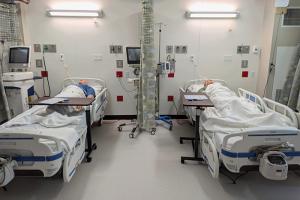Collaboration instead of confrontation

The journey to continually improve requires an outside set of eyes separate from each facility to ensure standards are maintained.
Image by Getty Images
Health care facilities professionals have all been there at one point in time or another. Whether it’s starting off a Monday morning after a long weekend on-call, a Wednesday afternoon when a facilities director has already given a few staff members the rest of the day off, or a Friday morning after an uneventful week. A call comes in over the radio from the desk that an authority having jurisdiction (AHJ) has arrived for an unexpected visit.
Historically, these types of notifications would send chills down the spine of the one responsible for meeting the AHJ and hopefully working with them for the remainder of the day or, even better, just a few hours. In the back of the health care facilities staff member’s mind, they may be thinking that they want to make sure this visit does not cause undue stress and anxiety for the hospital staff and, most importantly, does not garner any additional unwanted attention.3
Why do these feelings exist? The presumption of the health care facilities professional is the encounter will be adversarial in nature. In other words, us versus them. There is an expectation that the facility will receive bad news, receive citations and possibly be subject to some type of operational or financial penalty, depending on what is observed.
These feelings are understandable as a comparison can be drawn to a motorist being pulled over by law enforcement. Like the health care facilities professional, the motorist is thinking that nothing good can come from what is about to happen. Does it have to be this way? Not necessarily, if one explores where both sides are coming from.
The role of the AHJ
The AHJ is an organization or individual who is responsible for enforcing codes and regulations. AHJs can be from the public sector as well as the private sector, also known as governmental and non-governmental.
Governmental AHJs include state or local fire marshals, building code inspectors, department of health officials and federal inspectors from the Centers for Medicare & Medicaid Services (CMS). Depending on the part of the country where a health care facility is located, an AHJ can even be tribal. The Bureau of Indian Affairs and the Office of Self Governance are agencies that oversee tribal governments, support tribal sovereignty and fulfill the role of an AHJ on federally recognized tribal lands.
Resources
Non-governmental AHJs include privately owned accrediting organizations (AOs) or trade organizations that require members to meet certain requirements to maintain membership.
Both public and private AHJs fulfill several important roles. The primary role of an AHJ is to interpret, implement and enforce codes and standards; perform inspections; and ensure health care facilities meet minimum safety requirements. Secondary roles can include, but are not limited to, issuing permits; approving design plans, infrastructure equipment and installations; and ensuring environmental health.
Although it sometimes may not seem like it, AHJs do not set out to make the job of health care facilities professionals more difficult. Enforcing codes and regulations is not an easy task, and despite their best intentions, AHJs do not always evaluate everything perfectly the first time! There is a simple reason for this: AHJs are people too, who just want to do the right thing to make situations better and safer for everyone.
Most people either directly use health care or have friends and family who utilize health care services at some point in their lives. Given this universal need and the unknown as to when, how and where one would need to access health care services, patients and patients’ representatives require assurance their needs will be taken care of in a safe and healthy environment.
Despite the best efforts of health care facilities staff, near misses, adverse events and accidents unfortunately occur in hospital settings. The journey to continually improve requires an outside set of eyes separate from each facility to ensure standards are maintained, accountability is tantamount and as much bias is removed as possible.
Three common questions
The three most common questions that are asked by health care facilities professionals when discussing among themselves interactions with AHJs are the following:
What should facilities professionals do if they think the AHJ is wrong? Prior to engaging this potentially risky topic, a couple of things typically occur in advance. Facilities professionals should ask themselves why they believe the AHJ is wrong. How well do they know the code? Is there a meeting of the minds as to what is being cited?
Just because something may sound incorrect does not necessarily mean it is wrong. Even the most experienced health care facilities professionals can be wrong about current codes and standards.
First, they should ask the AHJ to clearly state and repeat exactly what the code violation is and what code or regulation is being cited. Posing these requests for clarifications as educational opportunities can help ease the tension of the request. Prior to engaging the AHJ, facilities professionals should ensure proper research is completed to fully understand the referenced code and ensure applicability. Understanding applicability is key and tends to be the most common arbiter of disputes between parties in these situations.
CMS mandates all participating hospitals follow the 2012 editions of the National Fire Protection Association’s NFPA 101®, Life Safety Code®, and NFPA 99, Health Care Facilities Code. In addition, all subsequent referenced publications in Chapter 2 of these codebooks apply to varying degrees.
Perhaps the AHJ is referencing a codebook that is not fully traceable through the 2012 edition of NFPA 101 or NFPA 99? An example would be an AHJ applying the 2021 edition of the American National Standards Institute/ASHRAE/American Society for Health Care Engineering Standard 170, Ventilation of Health Care Facilities, which requires operating rooms or Class 3 imaging rooms designated for orthopedic procedures, transplants, neurosurgery or dedicated burn unit procedures to provide HEPA filters at the air terminal device, while the 2008 edition does not require this.
Another common example when it comes to scope and applicability involves misapplying the proper occupancy. For example, are health care occupancy codes being applied to a business occupancy? If a hospital has multiple occupancies, does the AHJ have the correct information to properly apply the codes and regulations being evaluated? Sharing the current life safety plans of the facility can help avoid these misapplications.
What should facilities professionals do if the AHJ is interpreting a code differently than what the professional has heard before? When a hospital is being evaluated for code compliance, several different types of AHJs can potentially weigh in. Because health care is one of the most-regulated fields in the United States, it is normal to have a half-dozen or even more AHJs. A common question asked by health care facilities professionals is, “What if the first AHJ says something different than the second AHJ on the same topic?”
When codes and standards appear to conflict, the more stringent standard always applies. This topic tends to appear most often between governmental AHJs and non-governmental AHJs, such as a private AO versus a fire marshal. When a private AO performs an accreditation survey, they evaluate compliance with the CMS-approved accreditation standards, in addition to anything else the hospital says it should be doing per their internal policies and procedures.
For example, the 2010 edition of NFPA 10, Standard for Portable Fire Extinguishers, is the current approved codebook per the CMS mandate of NFPA 101, 2012 edition, and requires that fire extinguishers be inspected annually. However, if the hospital has an internal policy/procedure that says “fire extinguishers shall be inspected at intervals of not more than [six] months,” there would be a conflict. In this case, the hospital has a more stringent requirement. Conversely, if the fire marshal says the fire extinguishers are subjected to maintenance at intervals of not more than two years, then, once again, the more stringent standard applies, whether it be the AO, the hospital internal policy/procedure or the local requirement. Understanding and applying this concept can minimize misunderstandings and potential tension between AHJs and how they interact with a hospital.
Another common example in which the AHJ and the health care facilities professional may not agree on an observation pertains to tracing fire and smoke barriers. If a hospital does not maintain current life safety drawings, the AHJ is forced to determine penetrations in fire and smoke barriers based on visual observations only, whether a wall is truly part of the “fire barrier” or not. When a wall is listed as a 2-hour fire barrier and there are no drawings available to confirm, the determination is made upon observation by the AHJ.
What should facilities professionals do if the AHJ is citing a facility based on their opinion and not a code or a standard? Whenever human beings are involved, it is difficult to expect that site evaluations will be void of all opinions. Anyone tasked with enforcing codes and regulations ultimately wants to do the right thing. Most people who get involved in the health care field are very passionate about what they do and how to make the environment as safe as possible for every patient who receives services at their local hospital.
Understanding and differentiating between a requirement and a best practice can be a challenge. While navigating various codebooks and applying requirements, it is critical to separate terms such as must and shall versus should or recommend. Whenever the terms must and shall appear in a codebook, these are requirements and will be found in the code section. Whenever the terms should or recommend appear, these are suggestions or best practices and not requirements.
For example, if an AHJ says the smoke detectors are too close to the air diffusers and are “required” to be at least 36 inches away from the source, it is time to do some research.
The 2010 edition of NFPA 72®, National Fire Alarm and Signaling Code®, is the applicable codebook per CMS and requires detectors to be positioned so the flow of air within the space does not prevent the device from operating. Within the appendix language for this section is a recommendation that detectors should not be located closer than 3 feet from direct airflow.
In this example, the difference in the wording between the code section “shall not” and the appendix section “should not” provides guidance about the distance from the direct airflow. This is a key distinction and not an official requirement. Although this example does touch on applicability, the AHJ may perhaps be trying to enforce a section of the codebook based on their opinion.
A shared goal
Health care facilities professionals have the best chance of a positive experience with an AHJ by remaining professional, performing due diligence and understanding that there is a shared goal to make the health care environment as safe as possible for everyone.
Facilities professionals should avoid the historical presumption of an adversarial relationship by approaching a site visit with an understanding of scope and applicability, knowledge of when codes and standards collide, and appreciation of what is required versus opinion. Most importantly, they should keep an open mind.
Practicing clear communication, asking questions and exercising mutual respect will go a long way toward maintaining a long-lasting and sustainable relationship with any AHJ.
Related article // Rural facility receives guidance from authority having jurisdiction
A critical access hospital (CAH) in the southern United States received a site visit from its state fire marshal because state records indicated the facility was overdue for a visit. The rural facility, which is the only hospital in its county, was converted several years earlier from a one-story office building that was not built as a hospital.
The hospital had a full-time engineer on staff as well as a part-time assistant to help when two sets of hands were needed to make necessary corrections. The CAH was struggling financially and prioritizing resources on primary patient needs, such as medications, patient care supplies and emergency department infrastructure, among others. The facility engineer was aware of the financial challenges the hospital was experiencing and had never gone through an inspection, given their relatively short tenure at the hospital.
The engineer was a member of the community and understood the importance of the hospital to the area. The engineer was nervous about what the fire marshal would find and feared that if things did not go well, the fire marshal might tag the building as not compliant with the fire code and possibly order an evacuation. If this happened, it would negatively impact the community and the hospital staff.
During the site visit, it became clear to the fire marshal the hospital was doing the best it could to keep its doors open. During the building tour, the fire marshal noted fire doors not latching, corroded sprinkler heads and a lengthy dead-end corridor. Upon completion of the site visit, the fire marshal shared these observations with the facility’s engineer.
Knowing some of these corrections were going to cost quite a bit of money or very well may be impossible to correct, the engineer shared the resource concerns with the fire marshal and eventually asked, “What can we do to keep this hospital open in the safest way possible?”
The fire marshal noted there were a few areas of concern that should be very easy to address, such as some fire doors that were not latching upon closure and clearing unnecessary equipment clogging up the hallways. However, the hospital engineer noted that the sprinkler heads would require additional time and financing to repair and that the dead-end corridor was cost prohibitive.
A discussion ensued between the facility’s engineer and the fire marshal. The fire marshal shared that additional time would possibly be granted with the approval of a time-limited waiver for the sprinkler heads and a fire safety evaluation system for the dead-end corridor.
The fire marshal provided direction on the information needed to complete the documentation for the waivers and demonstrated willingness to work with the hospital and not insist the code be met no matter what without undue delay.
About this article
This article is one of a series contributed to Health Facilities Management by DNV Healthcare USA Inc.
Brennan P. Scott, CHFM, CHOP, is program manager for acute care/critical access hospital services, head of surveyor development and educator/trainer for DNV Healthcare USA Inc. in Katy, Texas. His email is brennan.p.scott@dnv.com.




